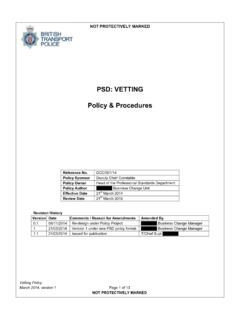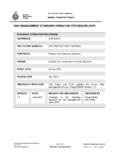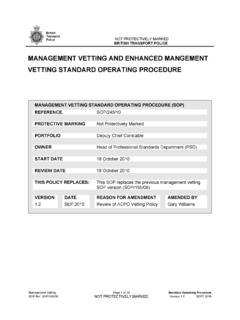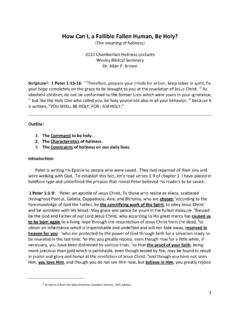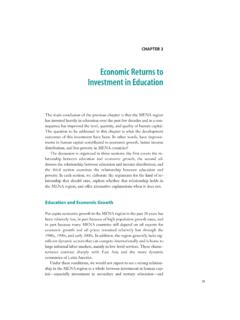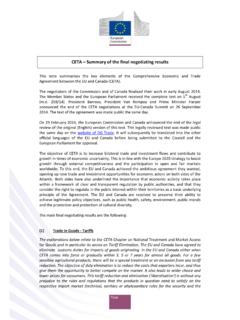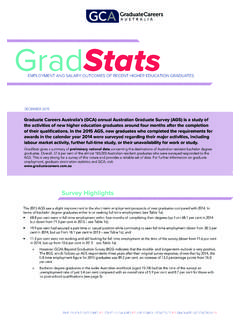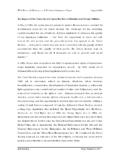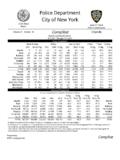Transcription of There when you need us - British Transport Police
1 Annual Report 2 016 /17 There when you need us1234567891011 Foreword Our continuing journey Our performanceOur year in reviewCountering the terrorist threatProtecting people from harm Suicide prevention Tackling hate crimeHelping to keep the network runningPride in our professionalismListening to our customersDesigning out crimeComplementing our resourcesOur peopleOur budgetHere when you need usClosing thoughts from the AuthorityContents2 Our continuing journeyIn 2016/17, British Transport Police (BTP) continued to transform as an organisation whilst responding to the ever-increasing operational demand presented by a successful, expanding railway number of passenger journeys made on the railway increased by million this year. There are now billion journeys every year. Responding effectively to this demand is essential if we are to continue to ensure the railway is a safe place to travel and help achieve this, our Demand, Resources and Deployment Programme examined the impact on our uniformed policing resources and looked at how they could be deployed, in the right place and at the right time.
2 Following extensive consultation, we put in place a nationally consistent rostering model that meets our operational need but also provides our officers with a more realistic and predictable pattern of ahead, we are carrying out a fundamental reassessment of our operational policing requirement through the development of a new target operating model, which will set out how BTP should function in future. This work will examine all of our operational and business functions, from the provision of frontline services, through to our support functions, such as human resources and training. It will link demand, outputs and inputs in a much more comprehensive manner across our the organisational changes that happened in 2016/17, our Police officers and staff responded to a number of high profile critical incidents. These included the tram derailment in Croydon in November 2016 in which seven people tragically lost their lives and more than 50 were injured; an explosive device left in a carriage on a Jubilee Line train at North Greenwich station in October 2016; and the terrorist attack on Westminster Bridge and at the Houses of Parliament in March 2017, which led to the deaths of five innocent people, including Metropolitan Police Service officer PC Keith Palmer, and around 50 more being injured.
3 333 The horrific events of Westminster, and more recently in Manchester and at London Bridge and Borough Market, are a stark reminder that the threat from international terrorism remains ever present. Our preparation techniques, and the way we work with other agencies as we continually test our preparedness, must keep pace with the terrorist threat. In response to this threat, we re-focused our budget to enable us to fund an increase in our counter terrorism capabilities, including the recruitment of a significant number of additional specialist firearms also launched the Department for Transport -sponsored See It. Say It. Sorted campaign in November 2016. Designed by Police , government and the rail industry, the campaign focuses on raising public awareness of the vital role they play in keeping themselves and others safe by reporting any unusual items or key priority is to protect people in mental health crisis on the network. Our activity in this area continued to grow in 2016/17.
4 Indeed, the number of calls for service we received where someone was experiencing mental health crisis or was suicidal and needed help, outweighed the number of violence with injury offences, sexual offences and robberies we Police officers and colleagues in local Police forces, together with rail staff and members of the public, made 1,837 life-saving interventions, physically preventing people from taking or attempting to take their life on the rail network. Although we have seen a reduction in suicides and suspected suicides on the network for a second consecutive year protecting vulnerable people when they most need it remains our key order to maximise our approach to ensure the safety of the travelling public and the reliability of the railway infrastructure, we have introduced a new performance management framework focused on reducing threat, risk, harm and vulnerability. Instead of working towards, often counter-productive, numerical targets, our new approach focuses on outcomes and a much broader range of measures to assess how we are doing.
5 This will help drive effective performance at a deeper level. It is important that the public and rail staff we serve have a say in how we Police the railways, and their views have been instrumental in shaping these pillars of performance, along with feedback from our Police officers and staff and our industry hope our annual report for 2016/17 will provide you with more detail about these issues and helps to tell the story of our organisation over the last Crowther OBE Chief Constable British Transport Police44 Our performancecrime on the railway has fallen by 34%criminal damage reduced by 55%theft of passenger property reduced by 47%motor vehicle and cycle crime reduced by 29%robbery decreased by 82%Key2006/072016/17 Overall crimeWhen travelling on the rail network in England, Scotland and Wales, the chance of you becoming a victim of crime is very low. For every million journeys made in 2016/17, we recorded only 16 recorded a total of 52,235 crimes in 2016/17 compared to 48,718 in 2015/16.
6 This reflects the national picture, with the other Police forces in England and Wales recording a higher increase in recorded is the result of a number of factors: the improvements we have made to how crime is recorded, helping to drive up accuracy; victims and witnesses now having more confidence to report crime to us, thanks in part to our discreet text 61016 service; and our effective campaign to encourage people to report unwanted sexual the last 10 years5 Suicide preventionThe total number of people who are suspected to have taken their own lives on the railway in 2016/17 is 290 15 fewer people than in 2015 received 9,546 calls for service in relation to people who were suicidal or in mental health crisis. The number of life-saving interventions increased by almost half (45%), with 1,837 people prevented from harming themselves on the out more about how we are protecting people from offencesWith our Report it to stop it campaign, together with the Mayor of London, Transport for London, the Metropolitan and City of London Police , we have continued to encourage people who experience unwanted sexual behaviour on the Transport network to report it to Police .
7 This led to a 9% increase in the number of sexual offences we recorded in 2016/17 180 more offences compared with the year before. We consider this to be a positive indication that more people are confident that they will be taken seriously and their report will be investigated. We have focused on sharing stories about offenders being brought to justice, to help show people that their report can make a difference and stop unwanted sexual behaviour happening to others. 6 When we are dealing with incidents, we are always conscious of balancing the need to carry out our work in a thorough, professional and dignified way, with an understanding of the importance of getting services back up and running year, we completed the necessary work to respond to all fatalities, including complex and challenging incidents, and hand back the line to train and rail operators in an average of 94 overall number of trespass incidents increased by nine per cent. There were also more trespass incidents that incurred delays of over 1,000 minutes.
8 People who trespass on the railway put their own and other lives at risk, therefore tackling this issue and reducing the impact of incidents will continue to be a priority for us in 2017 out how we are working with the industry to keep the network understand how frustrating it is for passengers and rail staff when disruption causes trains to be delayed or cancelled. Set against a context of an increasing number of rail passengers and journeys on the network, it is perhaps unsurprising that delays caused by disruption increased in 2016/17. Disruption to the railway can be caused in a number of ways, from fatalities and suicide attempts to reckless use of level crossings and people trespassing on the tracks. Sometimes this means we have to close down the line while we carry out our work, causing delays to confidence in BTPWe assess rail passengers confidence in the work we do by analysing the results of the National Rail Passenger Survey (NRPS), carried out biannually by Transport Focus.
9 The NRPS asks rail passengers how they feel about their personal security while using their railway station or on trains, which helps us to understand how we can better focus resources to improve passenger confidence. Findings from the latest NRPS (Spring 2017) reported a passenger confidence level of 78%, which means nearly eight out of 10 passengers would describe their experience as positive. Find out how we are working to improve the confidence of passengers and rail year in review2016 AprilWe launched a new approach to promoting and supporting our employees wellbeing, focusing on better anticipating challenges to their physical and mental health and providing an improved level of support. MayWe organised Exercise Eleanor, simulating a marauding terrorist attack with dozens of casualties, involving partners from London Fire Brigade and London Ambulance Novella saw us accompany thousands of football fans to France for the UEFA Euro 2016 Championship.
10 We were the only Police force to have extended jurisdiction on the French hard-hitting film was released to mark the launch of our #realitycheck campaign, aimed at discouraging trespass on the railway during the summer London, Night Tube began on the Victoria and Central lines, marking a significant moment for London and a huge operational change for BTP, with officers now patrolling London Underground throughout the announced plans for officers in Scotland to carry TASER devices to help better protect the public and bringing them into line with colleagues in England and provided a specialist immediate response to an incident at North Greenwich station, in London, when an explosive device was left on a Jubilee Line train. We confirmed it contained suspicious components and worked alongside colleagues from the Metropolitan Police Service to provide a safe and proportionate , seven people died and more than 50 were injured when a tram derailed and overturned near the Sandilands stop on the line between New Addington and Wimbledon, in south London.



